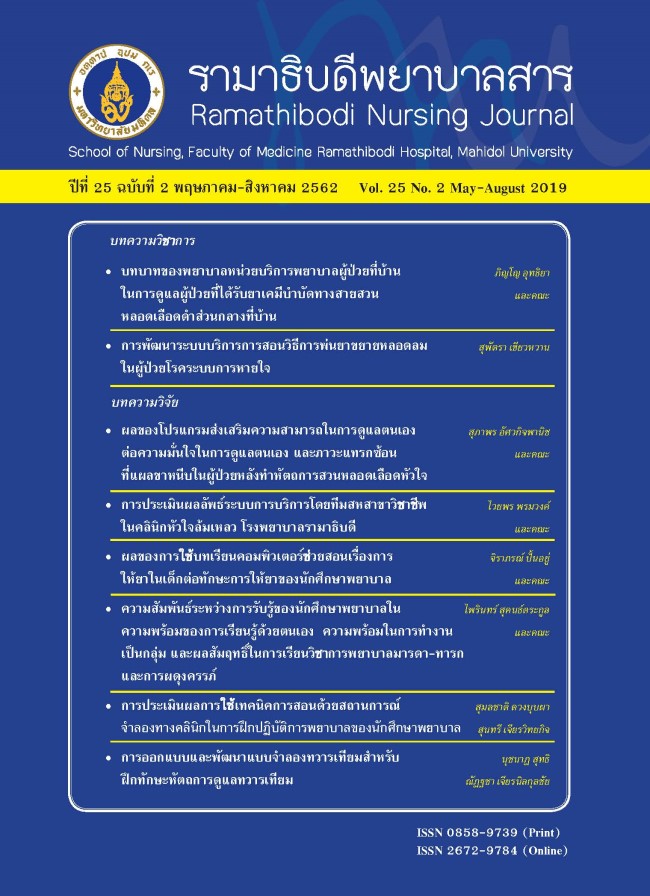Evaluation of Implementing Clinical Simulation Teaching Techniques in Clinical Practicum among Nursing Students
Main Article Content
Abstract
บทคัดย่อ:
การวิจัยครั้งนี้เป็นการวิจัยกึ่งทดลองแบบ 2 กลุ่มวัดก่อนและหลังการทดลอง เพื่อประเมินผลการใช้เทคนิคการสอนด้วยสถานการณ์จำลองทางคลินิกในวิชาการปฏิบัติการพยาบาลผู้ใหญ่และผู้สูงอายุต่อคะแนนความรู้ และความมั่นใจในการดูแลผู้ป่วยโรคระบบทางเดินหายใจและระบบหัวใจและหลอดเลือด และความพึงพอใจในการสอนด้วยสถานการณ์จำลอง กลุ่มตัวอย่างเป็นนักศึกษาพยาบาลชั้นปีที่ 3 จำนวน 114 คน แบ่งเป็นกลุ่มทดลอง 57 คน และกลุ่มควบคุม 57 คน โดยกลุ่มทดลองเรียนวิชาปฏิบัติการพยาบาลผู้ใหญ่และผู้สูงอายุ เป็นระยะเวลา 8 สัปดาห์ร่วมกับการเรียนด้วยสถานการณ์จำลองทางคลินิก 2 สถานการณ์ จำนวน 2 ครั้ง ส่วนกลุ่มควบคุมเรียนเฉพาะวิชาปฏิบัติการพยาบาลผู้ใหญ่และผู้สูงอายุ เก็บข้อมูลโดยใช้ 1) แบบบันทึกข้อมูลส่วนบุคคล 2) แบบทดสอบความรู้ในการดูแลผู้ป่วยโรคระบบทางเดินหายใจและระบบหัวใจและหลอดเลือด 3) แบบสอบถามความมั่นใจในการดูแลผู้ป่วยโรคระบบทางเดินหายใจและระบบหัวใจและหลอดเลือด และ 4) แบบประเมินความพึงพอใจต่อการเรียนด้วยการใช้สถานการณ์จำลอง วิเคราะห์ข้อมูลโดยใช้ สถิติเชิงพรรณนา ไคสแคว์ สถิติที สถิติทีคู่ และการวิเคราะห์ความแปรปรวนแบบวัดซ้ำ และค่าขนาดอิทธิพล (Partial η2 ) ผลการศึกษาพบว่า 1) หลังการทดลอง กลุ่มทดลองมีค่าเฉลี่ยคะแนนความรู้ และความมั่นใจในการดูแลผู้ป่วยโรคระบบทางเดินหายใจและระบบหัวใจและหลอดเลือด สูงกว่าก่อนทดลอง อย่างมีนัยสำคัญทางสถิติ (p < .05) 2) หลังการทดลอง กลุ่มทดลองมีค่าเฉลี่ยคะแนนความรู้ และความมั่นใจในการดูแลผู้ป่วยโรคระบบทางเดินหายใจและระบบหัวใจและหลอดเลือด สูงกว่ากลุ่มควบคุม อย่างมีนัยสำคัญทางสถิติ (p < .05) 3) สถานการณ์จำลองทางคลินิกส่งผลต่อความรู้ที่ร้อยละ 12 (η2 = 0.12) และส่งผลต่อความมั่นใจที่ร้อยละ 24 (η2 = 0.24) และ 4) กลุ่มทดลองมีความพึงพอใจต่อการสอนด้วยสถานการณ์จำลองในระดับมาก (ช่วงคะแนน 1- 5) ( M = 4.30, SD = 0.64) งานวิจัยนี้สะท้อนให้เห็นผลของการสอนด้วยสถานการณ์จำลองทางคลินิกต่อความรู้และความมั่นใจของนักศึกษาพยาบาล ดังนั้นสถานการณ์จำลองทางคลินิกจึงเป็นกลยุทธ์การสอนที่มีประสิทธิภาพในการพัฒนาทักษะการดูแลผู้ป่วย
Article Details
บทความ ข้อมูล เนื้อหา รูปภาพ ฯลฯ ที่ได้รับการตีพิมพ์ในรามาธิบดีพยาบาลสาร ถือเป็นลิขสิทธิ์ของวารสาร หากบุคคลหรือหน่วยงานใดต้องการนำทั้งหมดหรือส่วนหนึ่งส่วนใดไปเผยแพร่หรือเพื่อกระทำการใด ใด จะต้องได้รับอนุญาตเป็นลายลักษณ์อักษรจากรามาธิบดีพยาบาลสารก่อนเท่านั้น
References
nurses: a call for radical transformation. San Francisco,
CA: Jossey-Bass; 2010.
2. Transformative Education for Health Professionals
[Internet]. c2014 [cited 2019 Feb 10].Available from:
https://whoeducationguidelines.org/content/executivesummary
3. Kinsman L, Buykx P, Cant R, Endacott R, Missen K. The
FIRST 2ACT Simulation program improves nursing
practice in a rural Australian hospital. Australian Journal
of Rural Health. 2012;20:270 -74.
4. National Council of State Boards of Nursing (NCSBN).
Clinical instruction in pre licensure nursing programs.
c2005 [cited 2019 Feb 25]. Available from: https://
www.ncsbn.org/2822.htm?iframe=true&width=515&height=300.
5. Larew C, Lessans S, Spunt D, Foster D, Covington, BG.
Innovations in clinical simulation: application of Benner’s
theory in an interactive patient care simulation. Nursing
Education Perspectives. 2006;27(1):16-21.
6. Liaw S, Chan S, Siau C. Comparison of virtual patient
simulation with mannequin-based simulation for
improving clinical performances in assessing and managing
clinical deterioration: randomized controlled trial. Journal
of Medical Internet Research [Internet]. 2014 [cited 2019
Mar 13] Available from: https://www.ncbi.nlm.nih.gov/
pmc/articles/PMC4180357/
7. Jeffries P. (2007). Simulation in nursing education: from
conceptualization to evaluation.New York, NY: National
League for Nursing; 2007.
8. Cordeau MA. Teaching holistic nursing using clinical
simulation: a pedagogical essay. Journal of Nursing
Education and Practice. 2013;3(4):40-50.
9. Cook DA, Brydges R, Zendejas B, Hamstra SJ, Hatala R.
Mastery learning for health professionals using technologyenhanced
simulation: a systematic review and metaanalysis.
Acad Med. 2013;88:1178-86.
10. Stroup C. Simulation usage in nursing fundamentals:
Integrative literature review. Clinical Simulation in
Nursing. 2014;10(3):e155-e164. Available from:
https://www.nursingsimulation.org/article/S1876-
1399(13)00235-1/pdf
11. Kolb AY, Kolb DA. Learning styles and learning spaces:
Enhancing experience learning in higher education. Acad
Manage Learn Educ. 2005;4(2):193-213.
12. Faul F, Erdfelder E, Buchner A, Lang A-G. Statistical
power analyses using G* Power 3.1 : tests for correlation
and regression analyses. Behav Res Methods. 2009;41
(4):1149-60.
13. Boyd TL. The impact of high-fidelity human patient
simulation on clinical judgment of nursing students: a pilot
study [dissertation]. New Hampshire, University of New
Hampshire; 2009.
14. Kaiyawong S. Effect size: the most important product of
hypothesis testing. Panyapiwat Journal. 2017;19(1):276-87.
15. Liaw SY, Scherpbier A, Rethans JJ, Klainin-Yobas P.
Assessment for simulation learning outcomes: a comparison
of knowledge and self-reported confidence with observed
clinical performance. Nurse Educ Today. 2012;32:
e35–e39. Available from:https://www.clinicalkey.com/
service/content/pdf/watermarked/1-s2.0- S026069
1711002681.pdf?locale=en_US
16. Tawalbeh L, Tubaishat A. Effect of simulation on
knowledge of advanced cardiac life support, knowledge
retention, and confidence of nursing students in Jordan.
Journal of Nursing Education. 2014;53(1):38-44.
17. Sinthuchai S, Ubolwan K, Boonsin S. Effects of highfidelity
simulation based learning on knowledge,
satisfaction, and self-confidence among the fourth year
nursing students in comprehensive nursing care practicum.
Rama Nurs J. 2017;23(1);113-7.
18. Parker BC, Myrick F. A critical examination of highfidelity
human patient simulation within the con-text of
nursing pedagogy. Nurse Educ Today. 2009;29:322-9.
19. Neill MA, Wotton K. High-fidelity simulation debriefing
in nursing education: a literature review. Clinical
Simulation in Nursing. 2011;7(5):e161-e168.
Available from: https://doi.org/10.1016/j.ecns.
2011.02.001
20. Hill B. Research into experiential learning in nurse
education. British Journal of Nursing. 2017; 26(16):932-
38. Available from: https://doi.org/10.12968/
bjon.2017.26.16.932
21. Lestander Ö, Lehto N, Engström A. Nursing students’
perceptions of learning after high fidelity simulation: effects
of a three-step post-simulation reflection model. Nurse
Educ Today. 2016 May;40:219-24. Available from:
https://doi.org/10.1016/j. nedt.2016.03.011
22. Butler KW, Veltre DE. Implementation of active learning
pedagogy comparing low-fidelity simulation versus highfidelity
simulation in pediatric nursing education. Clinical
Simulation in Nursing. 2009;5(4):e129-e136.Available from: https://www.nursingsimulation.org/
article/S1876-1399(09)00142-X/pdf
23. Howard VM. A comparison of educational strategies for
the acquisition of medical-surgical nursing knowledge and
critical thinking skills: human patient simulator vs. the
interactive case study approach [dissertation].PA:
University of Pittsburgh; 2007.
24. Amod HB, Brysiewicz P. Promoting experiential learning
through the use of high-fidelity human patient simulators
in midwifery: a qualitative study. Curationis.
2019;42(1):1-7. Available from: https://www.ncbi.
nlm.nih.gov/pmc/articles/PMC6407320/pdf/CUR-
42-1882.pdf
25. Suwannakeeree W, Jullmusi O, Inkaew T, Tangkawanich
T, Rueangram S. Satisfaction and self-confidence in
critical care nursing of nursing students learning with
simulation-based learning. Journal of Nursing and Health Sciences. 2017;11(3):167-77.
26. Stayt LC, Merriman C, Ricketts B, Morton S, Simpson T.
Recognizing and managing a deteriorating patient: a
randomized controlled trial investigating the effectiveness
of clinical simulation in improving clinical performance
in undergraduate nursing students. J Adv Nurs.
2015;71(11):2563-74.
27. Ponto M. Nursing students’ perceptions of autonomy: a
qualitative study. Progress in Health Sciences. 2011;1(2):11-7.


